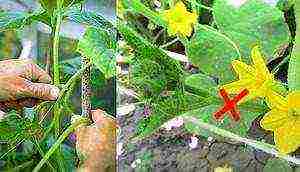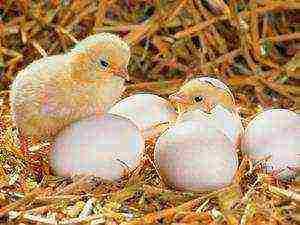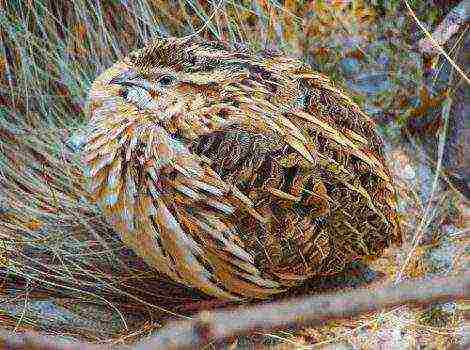Content
- 1 Grow in the shade
- 2 1. Aglaonema
- 3 2. Aspidistra
- 4 3. Asplenium
- 5 4. Gelksina
- 6 5. Sansevieria
- 7 6. Scindapsus (Potos)
- 8 7. Philodendron climbing
- 9 Grow in partial shade
- 10 8. Dracaena bordered
- 11 9. Ferns
- 12 10. Ivy
- 13 11. Tolmia
- 14 12. Fatsia
- 15 13. Ficus dwarf
- 16 14. Fatshedera
- 17 15. Fittonia
- 18 Shade-loving indoor plants
- 19 Blooming
- 20 Decorative deciduous
- 21 Palm trees and large trees for the home, growing in partial shade
- 22 Curly shade tolerant
- 23 Features of shade-loving colors
These 15 plants do not suffer from lack of sun. They can grow in the shade, away from the window. Direct sunlight is even destructive for many of them.
Let's say right away - most of the plants described in this article belong to the category of decorative-leaved, that is, all their charm is not in flowers, but in beautiful leaves. But even this is a lot, considering the "sun-free" diet, which they are usually on in our apartments.
Grow in the shade
These plants do quite well in a dark room, the windows of which are not facing the sunny side. The pots can be safely placed far from the window, in the back of the room.
1. Aglaonema
All the beauty of aglaonema is in its oblong variegated leaves. The flower grows very slowly, so you can transplant it every three years. Aglaonema loves feeding, warm and humid air (you will have to spray often). At the same time, it does not tolerate drafts and smoke. Plant the plant in a low pot and out of direct sunlight. However, in full shade, yellow or white-green leaves will lose their decorative effect: from variegated they will turn into ordinary green ones.
2. Aspidistra
One of the most hardy indoor plants - it is not for nothing that the British call it "cast iron". Aspidistra is not afraid of either polluted air, or rare watering, or dry air. However, direct sunlight can burn the leaves, so keep the pot of aspidistra away from the window. It is necessary to transplant a flower only if absolutely necessary - once every five years.
3. Asplenium
The second name of this plant is Kostenets nesting, the British call it more poetically: Bird's Nest Fern - which means "fern is a bird's nest." This plant of the fern family is rather large: its xiphoid leaves reach 60 cm in length. Asplenium, like a true fern, loves shade and moist air. Regular spraying is mandatory. Never place a pot with a plant next to a central heating radiator - dry, warm air is destructive for it. Another limitation is that you should not touch the young leaves of asplenium - they do not like this.
4. Gelksina
The moss-like Gelksin with tiny delicate leaves looks beautiful in hanging pots, as well as in pots next to large, tall plants. Gelksina covers the soil with a graceful green carpet. But be careful: do not plant it to low plants - gelksina can "strangle" them. Frequent watering and spraying is required of you. Propagating gelksina is very simple: pinch off a small lump of earth with several stalks and dig in a new pot.
5. Sansevieria
Sansevieria, she is "Mother-in-law's tongue", she is "Snake skin", grows in the sun and in the shade, tolerates dry air, drafts and occasional watering, it can not be transplanted for years, and the plant will remain strong and beautiful. Choose what is closer to you - tall leaves up to 1 m or low dense rosettes. Both those and other varieties are equally not whimsical. The only thing that sansevieria cannot stand is waterlogging of the soil. In winter, you can forget about watering altogether.
6. Scindapsus (Potos)
In Britain this liana with variegated waxy leaves is called "Devil's Ivy". Yellow or white streaks, streaks and splashes adorn the bright green leaves of scindapsus. However, be prepared for them to fade slightly in full shade. This popular plant looks great in a hanging pot or when planted on a wall. Does not tolerate drafts, dry air and direct sun. Spray the scindapsus often. In order for the plant to branch, the ends of the stems are pinched.
7. Philodendron climbing
Philodendrons are tropical plants that love very humid air and diffused light. The climbing philodendron with bright green shiny leaves is the smallest and most unpretentious of the entire family. It grows well in the shade. This is a liana, so be sure to stick a shaggy column into the pot, which will become a support for the plant. And don't forget to spray regularly. By the way, this is the brother of the giant beauty monstera (after all, its second name is Philodendron perforated).
Grow in partial shade
For normal growth, these plants just need to be away from a well-lit window, and even a window in which there is no sun will become a luxurious haven for them.
8. Dracaena bordered
Dracaena is also called "false palm" for its external resemblance - a lignified stem with a bunch of leaves at the top is very reminiscent of a spreading palm tree. Dracaena bordered with narrow and long (up to 70 cm) leaves - one of the most undemanding in the family. She easily puts up with shade, careless maintenance and a drop in temperature in winter (even below + 10 ° C). Dracaena will feel best in light shade, near the east or west window. It should be sprayed at least occasionally.
9. Ferns
More than two thousand species of ferns are suitable for growing at home. These tropical plants are ready to stay in the shade, but they will not tolerate dry air. The easiest ferns to keep are: citromium, davallia, Cretan pteris, nephrolepis, nesting bone, round-leaved pellet. But even they need frequent spraying of the leaves, especially during the heating season. Keep the soil in the fern pot moist at all times.
10. Ivy
A very popular liana that grows rapidly, covering the walls with a green "waterfall". There are a great many species of ivy - with oval and star-shaped, even and corrugated leaves. Plants with a uniform color of leaves are less spectacular than variegated ones - yellow and white-green. The secrets of success in growing ivy: partial shade, mandatory support, frequent spraying (including in winter!), Transplanting every two years into a larger pot.
11. Tolmia
This bush of "fluffy" bright green leaves is one of the hardiest indoor plants. It feels great in a cool room away from direct sun. Drafts are not scary for tolmiya. But hot and dry air is destructive for her. In tolmiya, offshoots are formed on the leaves, which are easily rooted, turning into a new plant.
12. Fatsia
Fatsia has been cultivated since Victorian times (19th century) for its beautiful shiny leaves. The plant loves coolness and bright light, but can adapt to any conditions. It is better to purchase a small plant - it will grow quickly (if you feed it and replant it annually) and after a couple of years it will reach a meter height.
To get a voluminous bush, trim the ends of the shoots every spring.Fatsia loves frequent spraying, as well as taking a shower from time to time.
13. Ficus dwarf
Unlike its "big brother" - the famous rubber-bearing ficus - this is a small ground cover (ampelous) plant, capable of twisting with greenery and a pillar-support, and the earth in a wide pot. It has a thin, wire-like stem and small (up to 2.5 cm) heart-shaped leaves. It does not tolerate bright sunlight and dry air, so keep the dwarf ficus away from the window, spray and water often with warm water. Dislikes frequent transplants.
14. Fatshedera
A hybrid of fatsia and ivy is as unpretentious as its progenitors. Prefers coolness, but in winter it can withstand temperatures up to + 20 ° C. It can grow as a bush, like a fatsia, or curl along a support, like ivy. If in the summer you keep the fatshedera in the back of the room, in the winter it is better to rearrange it on the windowsill. Spray the leaves as often as possible and make sure that the soil in the pot does not dry out.
15. Fittonia
This plant is easily recognizable by its characteristic web of white, pink or red veins on velvet oval leaves. It grows well in partial shade, but only under one condition - if you can provide it with a constant high humidity. That is why Fittonia is preferred to grow in a terrarium or "bottle garden". In the spring, the bare shoots are cut off, and the plant itself is divided.
On my own I would like to add Chlorophytum to this list, it considered appropriate for novice florists, as it is completely non-demanding to care and grows well indoors. The main thing for dimly lit rooms is to choose non-variegated varieties and it will decorate your home. Chlorophytum feels great in the kitchen, a real air filter)
Here is my handsome man and he is standing a few meters from the window ... Only the stripes have become less expressive.

For rooms where sunlight rarely reaches, these indoor plants can be a real salvation. They feel great in partial shade and in low light.
Most of the plants from the collection all the beauty is not in flowers, but in beautiful leaves. But that's a lot, considering the sunless "diet" and how they perfectly clean the air.
Calathea
The patterned leaves make this plant a welcome addition to any room, but keep in mind that direct sunlight is undesirable for it. The best option for calathea is partial shade.
Dieffenbachia
Diffused light is best for this plant. It is best to keep it behind a curtain. The plant is especially beautiful in the spring and summer, when light, delicate leaves appear in the center.
Dracaena marginata
This is a real slice of the tropics on the office desk. But keep the plant out of direct sunlight - they can damage them. The plant loves shade.
Chlorophytum crested
A very unpretentious plant, therefore, quite popular. It can go without the sun for a long time and at the same time perfectly purifies the air.
Gelksina
A plant with tiny delicate leaves looks beautiful in hanging pots and in pots next to tall plants. But be careful: do not plant it on low plants - gelksina can "strangle" them. Frequent watering and spraying is required of you.
Ferns
More than 2000 species of ferns are suitable for growing at home. These tropical plants are ready to stay in the shade, but they will not tolerate dry air. They need frequent spraying of the leaves, especially during the heating season.
Philodendron heart-shaped
Perhaps this is a favorite plant of many flower growers. Feels good in the shade, perfectly cleans the air. Occasionally pinching is required so that it does not stretch too long.
Neoregelia
A tropical plant that thrives on artificial light only. It thrives in humid conditions such as bathrooms.
Spathiphyllum
If you often forget to water your plants and almost no sunlight enters the room, you can pick up such a beautiful and unpretentious flower for yourself.
Aglaonema
One of the best options for a low light room. Ideal for beginner gardeners.
Sansevieria three-lane
A plant that requires little or no maintenance. Light affects its growth, but it lives well in the dark.
Aspidistra high
This plant perfectly tolerates shade, heat, cold. But it will take a little patience as it grows very slowly.
Preview photo credit happymodern, beyondstores
Houseplants decorate the home and make the life of the modern city dweller more joyful. And even if the city apartment is not always sunny and spacious. There are many - large and compact, bright and modest shade-loving, decorative leafy and flowering, - capable of decorating any home, even a dark hallway. For example, those that do not need bright lighting.
Shade-loving indoor plants
In urban dwellings, there is often a shortage of well-lit, sunny places. Therefore, those who love shade are especially appreciated. Sciophytes - "plants of the shade" - this is how the representatives of the flora, who prefer shaded places, are called. They are also known as heliophobes - those who are afraid of the sun.
These amazing plants feel comfortable in partial shade, out of direct sunlight. Only here their beauty is fully revealed, the leaves become fabulously decorative, and the flowering becomes the most effective and abundant.
Bright light if not destructive, then definitely - not useful... The ancestral home is the gloomy deciduous forests of various parts of the world. Under their shade, the leaves acquire an exotic color, only here flowering is possible.
Many shade-tolerant inhabitants of the lower tiers of tropical and subtropical forests settled in city apartments. And now the best places for them are the northern and western home windowsills, the shaded corners of the rooms, where only diffused light falls.
Among them are those that do not bloom or have very modest inflorescences, but have extremely decorative leaves of various colors. Others are distinguished by colorful flowers.
Some of the shade-loving ones are luxurious and large, many are graceful and airy unpretentious plants. Each one needs the right placement and special reverent, loving care.
Blooming
A small part of the shade-loving plants boast luxurious flowers. However, even among them, spectacular species are known that can make up an exquisite collection.
Anthurium - a flower that prefers shade
For good health, this exotic plant needs partial shade from spring to autumn and diffused light in the cold season. Blooms from mid-spring to late summer. The anthurium cob inflorescence is framed with a bright "wax" blanket.
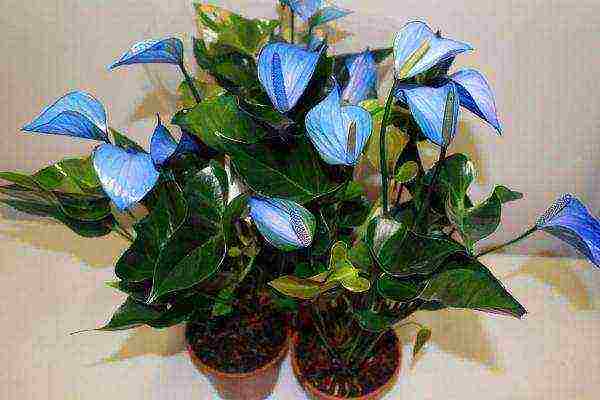 Anthurium with blue flowers
Anthurium with blue flowers
Requires regular, but not excessive watering, air humidification, adherence to temperature conditions (constant temperature of about 15 degrees).
Clivia
Good lighting needed, but indirect sunlight. Annual flowering will provide a winter rest, during which the flower needs to be moved to a cool room (with a temperature below 12 degrees), reduce watering and stop feeding. The rest of the time his no need to move, replant, waterlogged.
 Bright clivia flowers
Bright clivia flowers
Occasionally you need to wipe the leaves with a damp soft cloth.
Bell-shaped red, yellow or orange flowers, collected in an inflorescence on a high peduncle, look bright and very impressive.
Vriezia
A bright representative of the "atmospheric" bromeliads. The 70-centimeter inflorescence with bright bracts makes it memorable. For luxurious flowering, a stable temperature in the range of 19-28 degrees is required, and constant moisture to the outlet.
 Vriezia
Vriezia
Sempolia or Uzambara violet
This flower, although it needs a sufficient amount of light, does not tolerate direct sunlight: spots of burns appear on the leaves, their color fades, there is no flowering. The best option for placing violets is light partial shade, diffused light.
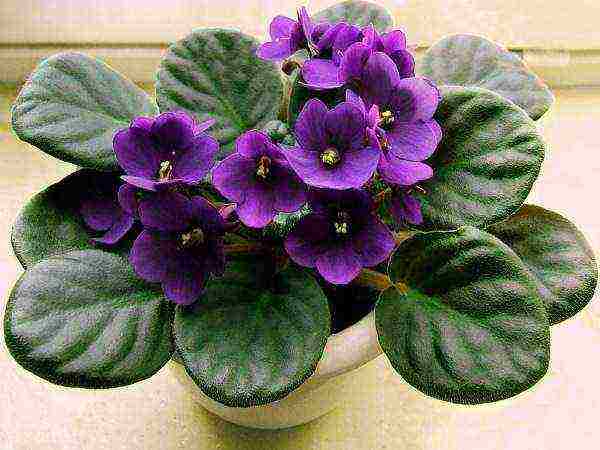 Violet is a very popular flower
Violet is a very popular flower
Decorative deciduous
The main advantage of ornamental deciduous plants is spectacular color of their leaves... At the same time, flowers can be small and inconspicuous.
Sansevieria
This plant of "strict lines" amateur flower growers call "mother-in-law's tongue" and "pike tail". Many varieties have been bred with various color combinations in the color of leathery leaves.
In partial shade, the contrast of color spots becomes brighter... In favorable conditions, sansevieria blooms, throwing out long "candles" of white and yellowish inflorescences.
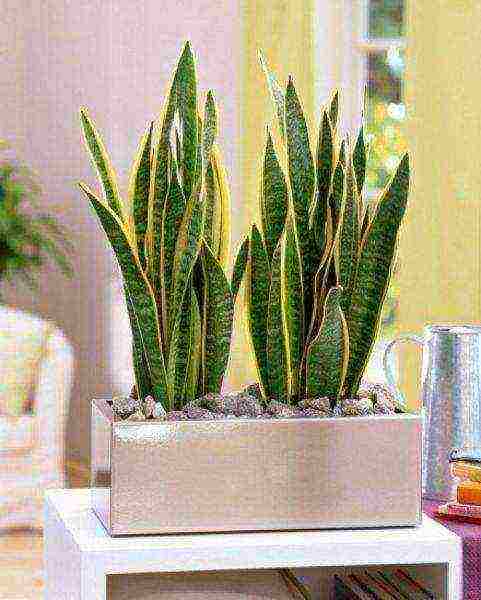 Sansevieria
Sansevieria
Ferns - love dark places
Among the many types, you can choose for both home and office, large or compact species. For example, broadleaf Asplenium or delicate thin-leaved Maidenhair (Venus hair).
All of them prefers shade or partial shade, moist air and soil.
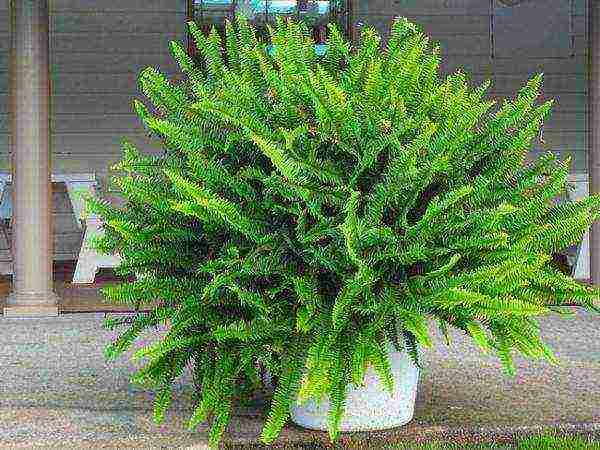 Ferns
Ferns
Fat woman (money tree)
The money tree does not tolerate shade well, but feels comfortable in dim lighting. Abundant watering is not required.
 Money Tree
Money Tree
Ficus
Compact ampelous and dwarf species need partial shade, they bright light is contraindicated... Moderate watering, air humidification, temperatures above 12 degrees are required.
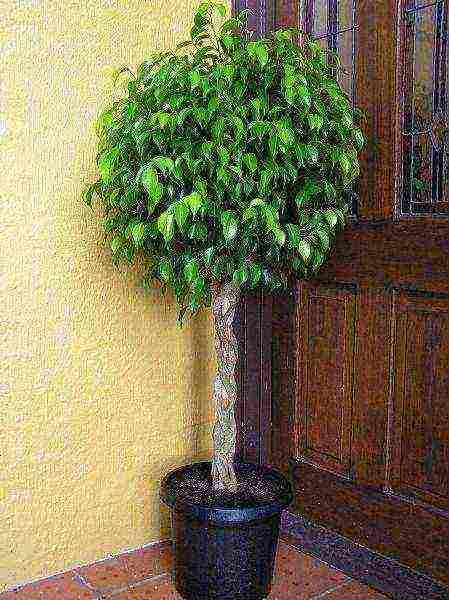 Ficus
Ficus
Sheflera
It takes root well in a bright room, but at some distance from the window. Frequent spraying of the leaves is required and the temperature is maintained at 12 to 20 degrees. Bred compact and large species.
 Sheflera
Sheflera
Palm trees and large trees for the home, growing in partial shade
Such plants will decorate a spacious room, office or winter garden.
Dracaena
A tree-like plant with a contrasting coloration of narrow, long leaves. Depending on the type of dracaena, it grows from 70 cm to 3 m in height. To preserve decorativeness, it is necessary sufficient, but not bright lighting, moderate moisture.
 One of the types of dracaena
One of the types of dracaena
Cordilina
Height from 0.5 to 2 meters... Often grown in tubs. It differs not only in a variety of colors, but also in the shape of the leaves: they are very narrow, long, lanceolate, wide, round. Cordilina is often confused with dracaena.
 Cordilina on the windowsill on the north side
Cordilina on the windowsill on the north side
Monstera
Can't stand bright lighting at all... Loves "water treatments" - wiping and polishing leaves, spraying, abundant watering in summer and moderate in winter.
 Monstera
Monstera
Palm
Under this name, various species are combined that have one feature: a single growth point at the top of the stem. Most palms grown in indoor culture love partial shade, abundant watering in summer and less intense in winter, humid air.
Everyone does not tolerate drafts and transplants.
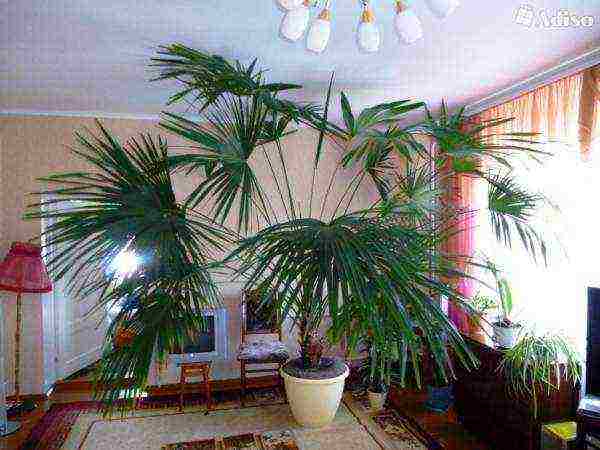 Palm
Palm
Curly shade tolerant
Climbing plants and vines are used to decorate the walls, create volumetric compositions.
Philodendron climbing
Does not tolerate direct sunlight and strong shade. Best accommodation - in bright but diffused light or in partial shade. Humidification is weak in winter, frequent and abundant in summer.
 Philodendron climbing
Philodendron climbing
Tradescantia
There are a huge number of species of this ampelous plant with a variety of leaf colors. To preserve decorativeness, he need partial shade or indirect bright lighting.
 Tradescantia
Tradescantia
Cissus
An excellent option for decorating large planes. The scope of imagination gives a variety of varieties - the leaves can be large leathery and small, tender, whole and dissected. It grows quickly, becomes attractive and beautifies the room.
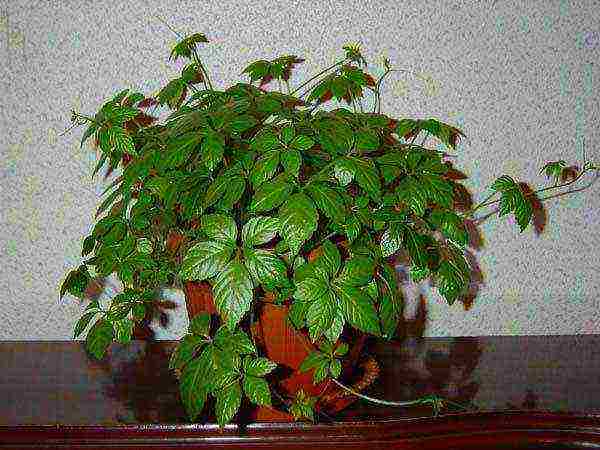 Cissus
Cissus
Features of shade-loving colors
All shade-loving plants have properties that distinguish them from others:
- the most vividly decorative qualities are manifested, if the flower is in the shade or partial shade most of the day;
- under intense lighting, development is inhibited, growth slows down, leaf color fades, flowering may not occur; in direct sunlight, the plant may get burned;
- need sufficient moisture in the soil and air;
- observance of the temperature regime is necessary;
- usually shade-loving do not tolerate frequent transplants.
Shade-loving plants are beautiful in their variety. They can be used to create refined, bright, stylish, light or respectable compositions that will become the main decoration of any room.
Insufficient illumination of premises is a common problem. Small windows or their complete absence, the west or east side of the world, deep dark corridors and bathrooms - all these are not the best places for greenery, but you really want to. But everything is not so bad, because you just need to choose the right variety of plants.
For a start, it is worth noting what exactly is meant by the concept of "dark room". If the windows of the room face the north side, then a distance of more than 1 meter from it is considered favorable only for shade-loving plants. For eastern windows, this distance reaches 3 meters, for western windows - 4.5 meters, but with southern problems it is less - the distance is as much as 9 meters.
The blessing of shade-loving indoor plants, beautiful and unpretentious in care, is great. There are decorative deciduous, and flowering, and curly landscaping, which likes to be constantly in partial shade. Naturally, for the placement of living plants in completely dark rooms without windows, it is necessary to provide for the presence of special artificial lighting.
So, the most common flowering plants for placement in rooms with an unfavorable side of the world or far from windows are spathiphyllum, gardenia, saintpaulia, vriezia, anthurium, clivia, calathea crocata and others. All of them tolerate a small dose of natural light well, but for their full bloom they must still receive weak diffused light.
Decorative deciduous shade-loving plants will also delight you with a wide variety of varieties, in which there are plants for every taste. It should be remembered that greens with variegated and white-green leaves need more light than plants with green foliage.
The brightest representatives of this group of plants are tradescantia, aucuba, calathea, fittonia, aglaonema, maidenhair, arrowroot, nephrolepis... All of them do not like the presence of a bright sun, so they will perfectly complement the darkened corners of the room. Many of them can only grow under artificial lighting conditions.
When choosing all kinds of palms, shrubs and large plants for darkened places, first of all pay attention to the color of their leaves. The darker the leaves, the easier the plant tolerates partial shade, and, accordingly, the easier it will be for you to care for it. Another advantage of this type of gardening is a great view in the overall interior design due to the large size in floor planters.
The most common plants of this type are hamedorea, dracaena, monstera, ficus, rapis, nurse and other types. All of them tolerate shade and partial shade well, so they will perfectly fit into the interior of dark rooms. In addition, it is these plants that are most common in the design of residential and public interiors, as they become wonderful full-fledged design elements.
Climbing shade-loving plants have a very important property that corresponds to the name, which allows you to create very interesting decorative compositions in the interior. These plants look very good in design.
The most common climbing plants are ivy, philodendron, scindapsus, synonym and others.Most of them, as a rule, are not too moody and do not need good lighting. It is important to place the plant correctly, providing it with support for full growth.
In any case, each of the listed plants has certain nuances of care. But the correct placement of "green" accents will help create a truly cozy and beautiful interior, and it is the shade-loving plants that will help with this!
